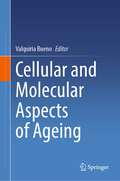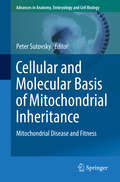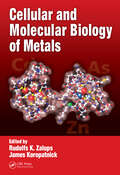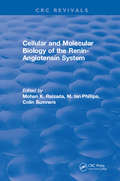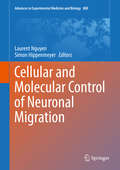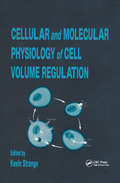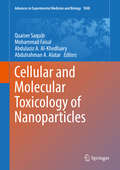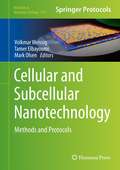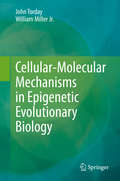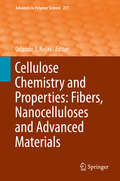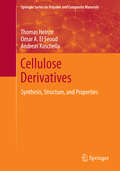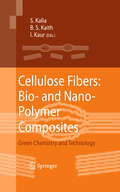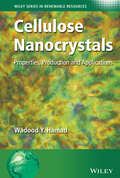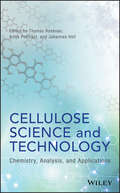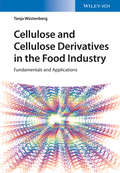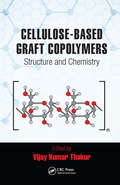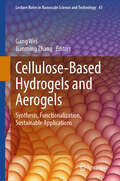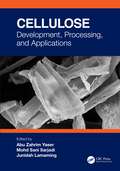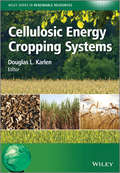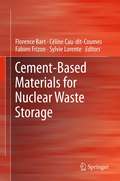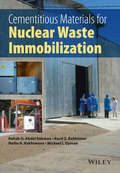- Table View
- List View
Cellular and Molecular Aspects of Ageing
by Valquiria BuenoEven though life expectancy increased in the last decades, ageing has been considered a strong risk factor for age-related diseases, disability and death. The further understanding of cellular and molecular aspects of ageing could predict the onset of diseases in advance, prevent functional decline and identify targets for interventions focused in healthy ageing. The hypothesis that organismal ageing and dysfunction is influenced by the accumulation of senescent cells had origin in Hayflick and Moorhead results from cultured human fibroblasts. It was shown that fibroblasts presented a limited capacity for proliferation reaching thus the state of irreversible growth arrest (replicative senescence). In 2011, van Deusen et al. showed that p16Ink4a accumulation was associated with premature ageing in a mouse model and the inactivation of the p16Ink4a gene mitigated the ageing phenotype. Thus, the cell cycle arrest due to the expression of p16Ink4a and p21CIP (cell cycle inhibitors) is the main characteristic of senescence. In addition to cellular senescence, the hallmarks of ageing include genomic instability, telomere shortening , epigenetic alterations, loss of proteostasis, deregulated nutrient-sensing, mitochondrial dysfunction, stem cell exhaustion, altered intercellular communication, and a pro-inflammatory senescence-associated secretory phenotype (SASP). In this book, researchers will comprehensively discuss relevant changes occurring at cellular and molecular levels (human and animal models) based on the hallmarks of ageing. The impact of lifestyle and benefits of physical activity and nutrition will be also discussed. Unravelling cellular and molecular aspects of ageing is crucial for the unanswered questions about ageing and for guiding interventions such as changes in lifestyle, senolytic (kills senescent cells), and senomorphic (interrupts deleterious intercellular communication) therapies.
Cellular and Molecular Basis of Mitochondrial Inheritance: Mitochondrial Disease and Fitness (Advances in Anatomy, Embryology and Cell Biology #231)
by Peter SutovskyThis new volume of our successful book series Advances in Anatomy, Embryology and Cell Biology is focused on mitochondrial inheritance in humans and both vertebrate and invertrebate animals including Drosophila, C. elegans, bivalve molusc Mytilus and livestock mammals. Special consideration is given to cellular mechanisms promoting uniparental inheritance of mitochondria and mitochondrial genes, evolutionary perspectives, and biomedical and epidemiological considerations. Contributed by five distinguished mitochondrial research teams from around the world, this volume will target a wide audience of physiologists, anatomists, cell, and developmental and evolutionary biologists, as well as physicians, veterinarians, livestock specialists and biomedical researchers.
Cellular and Molecular Biology of Metals
by Rudolfs K. Zalups D. James KoropatnickWith chapter contributions from more than 30 metal biology experts, Cellular and Molecular Biology of Metals explains the role of key divalent metal ions involved in the molecular and cellular biology of various target cell populations. Although it primarily focuses on homeostatic metals, such as nickel, zinc, and chromium, the text also discusses
Cellular and Molecular Biology of Nitric Oxide
by Jeffrey D. Laskin Debra L. Laskin"Provides the latest advances in the explosive growth of nitric oxide (NO) study-covering the behavior of this highly reactive molecule in a wide variety of physiologicial processes, including respiration, blood pressure, neurotransmission, nospecific host defense, and wound healing."
Cellular and Molecular Biology of the Renin-Angiotensin System
by Mohan K. RaizadaCellular and Molecular Biology of the Renin-Angiotensin System provides the first review and update of the state-of-the-art cellular and molecular aspects of the renin-angiotensin system. The book presents detailed analyses from world experts on each component of this system, including future directions. Topics range from angiotensin II receptor subtypes to processing of renin to the use of transgenic animal models for studying the role of this system in hypertension. Cellular and Molecular Biology of the Renin-Angiotensin System is essential reading for physiologists of the renin-angiotensin system, endocrinologists, cardiovascular specialists, renal physiologists, and neurobiologists.
Cellular and Molecular Control of Neuronal Migration (Advances in Experimental Medicine and Biology #800)
by Laurent Nguyen Simon HippenmeyerCellular and Molecular Control of Neuronal Migration provides an up-to-date collection of reviews on the molecular and cellular principles of neuronal migration in the mammalian brain. Over the last decades a rich catalogue of signaling molecules controlling neuronal migration has been compiled, and within this book an international panel of experts provides up-to-date discussions of the state of knowledge how these distinct signaling pathways regulate various aspects of neuronal migration. This book introduces the reader to the latest discoveries and concepts of neuronal migration enabled through the application of most sophisticated methods and cutting edge experimental approaches. Cellular and Molecular Control of Neuronal Migration also provides an update on the underlying cellular and molecular basis of neurodevelopmental migration disorders in human patients for all interested neuroscientists and clinicians.
Cellular and Molecular Physiology of Cell Volume Regulation
by Kevin StrangeThe ability to regulate cell volume in the face of osmotic challenge is one of the most fundamental of cellular homeostatic mechanisms. Cellular and Molecular Physiology of Cell Volume Regulation is an integrated collection of articles describing key aspects of cell volume control. The book has been organized around concepts and cellular/molecular processes rather than around mechanisms of volume regulation in specific cell types in order to make it more accessible to a multidisciplinary audience of students, instructors, and researchers.
Cellular and Molecular Phytotoxicity of Heavy Metals (Nanotechnology in the Life Sciences)
by Quaiser Saquib Mohammad Faisal Abdulaziz A. Al-Khedhairy Abdulrahman A. AlatarPlant growth and development is closely dependent on the plant environment, including the wide-spread presence of organic and inorganic xenobiotics and pollutants. Currently, heavy metals are the most common inorganic environmental pollutants and they have pronounced effects and consequences not only for plants, but also for the ecosystem in which the plants form an integral component. It has been suggested that these contaminants accumulate in agricultural crops, thus entering the food chain and posing a significant health risk. Plants growing in polluted sites exhibit altered metabolism, reduced growth, and decreased biomass production. These pollutants adhere to plant roots and exert physical or chemical toxicity and subsequently cell death in plants. Yet, plants have developed various defence mechanisms to counteract the toxicity induced by heavy metals. Only detailed study of the processes and mechanisms would allow researchers and students to understand the interactions, responses, and adaptations of plants to these pollutants; however, there are several unresolved issues and challenges regarding the interaction and biological effects of heavy metals. Therefore, this volume provides relevant, state-of-the-art findings on environmental phytotoxicity and the mechanisms of such interactions at the cellular and molecular levels. This volume consists of chapters on relevant topics contributed by different experts or group of experts so as to make available a comprehensive treatise designed to provide an in-depth analysis of heavy metals phytotoxicity. This book may serve as a reference to scientists, researchers and students in the fields of toxicology, environmental toxicology, phytotoxicology, plant biology, plant physiology, plant biochemistry and plant molecular biology, and especially those interested in heavy metals toxicology.
Cellular and Molecular Toxicology of Nanoparticles
by Quaiser Saquib Mohammad Faisal Abdulaziz A. Al-Khedhairy Abdulrahman A. AlatarThis edited book is a compilation of findings on the molecular and cellular toxicity of nanoparticles (NPs) in animal cell, human cells, invertebrates. The varied selection of test models will provide better understanding about the horizon of NPs toxicity. Interaction of NPs with cells and its organelles can induce toxicological consequences, including transcriptional and translational alterations, DNA damage, cytotoxicity, oxidative stress, mitochondrial dysfunction and cell death. NPs can get internalized in cells through phagocytosis, macropinocytosis, receptor-mediated endocytosis and passive penetration, which can affect varied cell types. Readers will be benefited with the compilations on basic and molecular facet of NPs toxicity. The chapters will provide a comprehensive information on the state-of-the-art methodologies. The application of toxicogenomic approaches, which is already established in nanotoxicology, has been given special consideration to unravel the toxicodynamics of nanomaterials. Among these approaches, the high-throughput RNA sequencing (RNA-Seq), which is able to build a complete map of transcriptome across different cell types and perturbations upon NPs exposure has been included. The readers are also introduced to the less studied topic on the adsorption of biomolecules (mainly proteins) on the NPs surface, constituting the so-called “biomolecular corona”. The book has been designed for scientists engaged in NPs toxicity research. Nonetheless, it should be of interest to a variety of scientific disciplines including marine biology, environmental pollution, genetics, pharmacology, medicine, drug and food material sciences, consumer products. Also, the compilations will be of interest to the environmental watchdogs, federal regulators, risk assessors and the policy makers.
Cellular and Subcellular Nanotechnology: Methods and Protocols (Methods in Molecular Biology #991)
by Volkmar Weissig Tamer Elbayoumi Mark OlsenIn Cellular and Subcellular Nanotechnology: Methods and Protocols expert researchers in the field detail the most recent advances which have been made in utilizing the enormous potential of nanotechnology for probing, imaging and manipulating life on a cellular and subcellular level. Written in the highly successful Methods in Molecular BiologyTM series format, chapters include introductions to their respective topics, lists of the necessary materials and reagents, step-by-step, readily reproducible laboratory protocols, and key tips on troubleshooting and avoiding known pitfalls. Authoritative and Practical, Cellular and Subcellular Nanotechnology: Methods and Protocols seeks to aid scientists in the further study of applying nanotechnology to all areas of biomedical sciences.
Cellular-Molecular Mechanisms in Epigenetic Evolutionary Biology
by John Torday William Miller Jr.There has been no mechanistic explanation for evolutionary change consistent with phylogeny in the 150 years since the publication of ‘Origins’. As a result, progress in the field of evolutionary biology has stagnated, relying on descriptive observations and genetic associations rather testable scientific measures. This book illuminates the need for a larger evolutionary-based platform for biology. Like physics and chemistry, biology needs a central theory in order to frame the questions that arise, the way hypotheses are tested, and how to interpret the data in the context of a continuum.The reduction of biology to its self-referential, self-organized properties provides the opportunity to recognize the continuum from the Singularity/Big Bang to Consciousness based on cell-cell communication for homeostasis.
Cellulases: Methods and Protocols (Methods in Molecular Biology #1796)
by Mette LübeckThis volume discusses the latest research and techniques used to study novel cellulases. The chapters in this book explore topics such as the role of cellulases in lignocellulose deconstruction for generation of a sugar platform for biofuel; screening for novel fungal b-glucosidases in a variety of fungal strains; discovery of novel enzymes in bacteria or fungi; protocols for isolating cellulolytic rumen bacteria; analysis of enzyme mixtures produced by ligocellulolytic fungi; and homology modeling. Written in the highly successful Methods in Molecular Biology series format, chapters include introductions to their respective topics, lists of the necessary materials and reagents, step-by-step, readily reproducible laboratory protocols, and tips on troubleshooting and avoiding known pitfalls.Cutting-edge and thorough, Cellulases: Methods and Protocols is a valuable resource for biochemists, molecular biologists, chemical engineers, and industrial researchers interested in this field.
Cellulose Chemistry and Properties: Fibers, Nanocelluloses and Advanced Materials (Advances in Polymer Science #271)
by Orlando J. RojasVincent Bulone et al. : Cellulose sources and new understanding of synthesis in plants Thomas Heinze et al. :Cellulose structure and properties Thomas Rosenau, Antje Potthast, Ute Henniges et al. : Recent developments in cellulose aging (degradation / yellowing / chromophore formation) Sunkyu Park et al. :Cellulose crystallinity Lina Zhang et al. :Gelation and dissolution behavior of cellulose Yoshiyuki Nishio et al. :Cellulose and derivatives in liquid crystals Alessandro Gandini, Naceur Belgacem et al. :The surface and in-depth modification of cellulose fibers Emily D. Cranston et al. :Interfacial properties of cellulose Herbert Sixta, Michael Hummel et al. Cellulose Fibers Regenerated from Cellulose Solutions in Ionic Liquids Qi Zhou et al. :Cellulose-based biocomposites Orlando Rojas et al. :Films of cellulose nanocrystals and nanofibrils Pedro Fardim et al. :Functional cellulose particles Wadood Hamad et al. :Cellulose Composites
Cellulose Derivatives
by Thomas Heinze Omar A. El Seoud Andreas KoschellaThis book summarizes recent progress in cellulose chemistry. The last 10 years have witnessed important developments, because sustainability is a major concern. Biodegradable cellulose derivatives, in particular esters and ethers, are employed on a large scale. The recent developments in cellulose chemistry include unconventional methods for the synthesis of derivatives, introduction of novel solvents, e.g. ionic liquids, novel approaches to regioselective derivatization of cellulose, preparation of nano-particles and nano-composites for specific applications. These new developments are discussed comprehensively. This book is aimed at researchers and professionals working on cellulose and its derivatives. It fills an important gap in teaching, because most organic chemistry textbooks concentrate on the relatively simple chemistry of mono- and disaccharides. The chemistry and, more importantly, the applications of cellulose are only concisely mentioned.
Cellulose Fibers: Green Chemistry and Technology
by Susheel Kalia B. S. Kaith Inderjeet KaurBecause we are living in an era of Green Science and Technology, developments in the field of bio- and nano- polymer composite materials for advanced structural and medical applications is a rapidly emerging area and the subject of scientific attention. In light of the continuously deteriorating environmental conditions, researchers all over the world have focused an enormous amount of scientific research towards bio-based materials because of their cost effectiveness, eco-friendliness and renewability. This handbook deals with cellulose fibers and nano-fibers and covers the latest advances in bio- and nano- polymer composite materials. This rapidly expanding field is generating many exciting new materials with novel properties and promises to yield advanced applications in diverse fields. This book reviews vital issues and topics and will be of interest to academicians, research scholars, polymer engineers and researchers in industries working in the subject area. It will also be a valuable resource for undergraduate and postgraduate students at institutes of plastic engineering and other technical institutes.
Cellulose Nanocrystals: Properties, Production and Applications
by Wadood Y. HamadResearch into cellulose nanocrystals is currently in an exponential growth phase, with research into potential applications now strengthened by recent advances in nanomanufacturing. The possibility of routine commercial production of these advanced materials is now becoming a reality. Cellulose Nanocrystals: Properties, Production and Applications provides an in-depth overview of the materials science, chemistry and physics of cellulose nanocrystals, and the technical development of advanced materials based on cellulose nanocrystals for industrial and medical applications. Topics covered include: • A comprehensive treatment of the structure, morphology and synthesis of cellulose nanocrystals. • The science and engineering of producing cellulose nanocrystals and the challenges involved in nanomanufacturing on a large industrial scale. • Surface/interface modifications of cellulose nanocrystals for the development of novel biomaterials with attractive structural and functional properties.• The scientific bases for developing cellulose-based nanomaterials with advanced functionalities for industrial/medical applications and consumer products. • Discussions on the (i) reinforcing potential of cellulose nanocrystals in polymer nanocomposites, (ii) utilization of these nanocrystals as efficient templates for developing tunable photonic materials, as well as (iii) applications in sustainable electronics and biomedicine. Cellulose Nanocrystals: Properties, Production and Applications will appeal to audiences in the physical, chemical and biological sciences as well as engineering disciplines. It will be of critical interest to industrialists seeking to develop sustainable new materials for the advanced industrial economies of the 21st century, ranging from adaptive “smart” packaging materials, to new chiral, mesoporous materials for optoelectronics and photonics , to high-performance nanocomposites for structural applications.
Cellulose Science and Technology: Chemistry, Analysis, and Applications
by Thomas Rosenau Antje Potthast Johannes HellThis book addresses both classic concepts and state-of-the-art technologies surrounding cellulose science and technology. Integrating nanoscience and applications in materials, energy, biotechnology, and more, the book appeals broadly to students and researchers in chemistry, materials, energy, and environmental science.• Includes contributions from leading cellulose scientists worldwide, with five Anselm Payen Cellulose Award winners and two Hayashi Jisuke Cellulose Award winners• Deals with a highly applicable and timely topic, considering the current activities in the fields of bioeconomies, biorefineries, and biomass utilization• Maximizes readership by combining fundamental science and application development
Cellulose and Cellulose Derivatives in the Food Industry
by Tanja WuestenbergAuthored by an expert with many years of experience as an application engineer at renowned cellulose processing companies in the food industry, this book presents all the conventional and latest knowledge available on cellulose and its derivatives. Throughout, the necessary details are elucidated from a theoretical and practical viewpoint, while retaining the focus on food applications. The book provides an essential source of informations including recommendations and instructions of a general nature to assist readers in the exploration of possible applications of cellulose and its derivatives and the generation of new ideas for product development. Topics include gelling and rheological properties, synergistic effects with other hydrocolloids, as well as nutritional and legal aspects. The resulting compilation covers all the information and advice needed for the successful development, implementation, and handling of cellulose-containing products.
Cellulose-Based Graft Copolymers: Structure and Chemistry
by Vijay Kumar ThakurCellulose-Based Graft Copolymers: Structure and Chemistry discusses the synthesis, characterization, and properties of multifunctional cellulose-based graft copolymers. Presenting the contributions of accomplished experts in the field of natural cellulosic polymers, this authoritative text: Offers an overview of cutting-edge technical accomplishmen
Cellulose-Based Hydrogels and Aerogels: Synthesis, Functionalization, Sustainable Applications (Lecture Notes in Nanoscale Science and Technology #41)
by Jianming Zhang Gang WeiThis book explores the rapidly advancing field of cellulose-based hydrogels and aerogels, highlighting their immense potential for sustainable applications in materials science, nanotechnology, biomedicine, tissue engineering, energy, and environmental science. With their highly porous structure, eco-friendly nature, excellent biocompatibility, and biodegradability, these materials offer remarkable versatility for next-generation sustainable technologies. This book presents cutting-edge research on the design, synthesis, and functionalization of cellulose-based hydrogels and aerogels. It demonstrates how their properties can be fine-tuned through integration with organic and inorganic materials and examines their wide-ranging applications in sustainable technologies. Despite their promise, challenges remain in achieving large-scale production with enhanced mechanical properties, controllable modifications, and functionalization for diverse applications. To address these issues, researchers have developed innovative strategies to refine synthesis methods, improve functionality, and expand potential uses. A valuable resource for researchers, postdoctoral scholars, PhD students, and engineers, this book serves as a comprehensive guide to the latest advancements and future directions in this growing field.
Cellulose: Development, Processing, and Applications
by Abu Zahrim YaserCellulose: Development, Processing, and Applications covers topics related to advanced cellulose development and processing, as well as the utilization of major agricultural and biomass waste. It discusses the utilization of cellulose from other agricultural and biomass materials, including oil palm biomass, bamboo, and other non-wood forest products in emerging areas. It covers the treatments used to improve the quality of cellulosic materials in specific applications. Following that, the book delves into the use of cellulosic materials in the application of composting science and technology. Features: Delves into the specific agriculture waste/biomass waste materials used for the advanced cellulose-based production Outlines the potential use of the covered materials for energy production and other emerging applications Includes composting technology and processes using the cellulosic materials Overviews industrial applications of cellulose from agricultural waste/biomass waste and composting technology Discusses the main agricultural waste/biomass in the Asian region This book is aimed at researchers and graduate students in chemical engineering, bioprocessing, composites, and biotechnology.
Cellulosic Energy Cropping Systems
by Douglas L. KarlenCellulosic Energy Cropping Systems presents a comprehensive overview of how cellulosic energy crops can be sustainably produced and converted to affordable energy through liquid fuels, heat and electricity.The book begins with an introduction to cellulosic feedstocks, discussing their potential as a large-scale sustainable energy source, and technologies for the production of liquid fuels, heat and electricity. Subsequent chapters examine miscanthus, switchgrass, sugarcane and energy cane, sorghums and crop residues, reviewing their phylogeny, cultural practices, and opportunities for genetic improvement. This is followed by a detailed focus on woody crops, including eucalyptus, pine, poplar and willow. Critical logistical issues associated with both herbaceous and woody feedstocks are reviewed, and alternate strategies for harvesting, transporting, and storing cellulosic materials are also examined. The final sectionof the booktackles the challenge of achieving long-term sustainability, addressing economic, environmental and social factors.Cellulosic Energy Cropping Systems is a valuable resource for academics, students and industry professionals working in the field of biomass cultivation and conversion, bioenergy, crop science and agriculture.Topics covered include:Identifying suitable cellulosic energy crops that are adapted to a wide range of climates and soilsBest management practices for sustainably growing, harvesting, storing, transporting and pre-processing these cropsThe development of integrated cellulosic energy cropping systems for supplying commercial processing plantsChallenges and opportunities for the long-term sustainability of cellulosic energy crops This book was conceived and initiated by David I. Bransby, Professor of Energy and Forage Crops in the Department of Crop, Soil and Environmental Sciences at Auburn University, USA. For more information on the Wiley Series in Renewable Resources, visit www.wiley.com/go/rrs
Cement-Based Materials for Nuclear Waste Storage
by Céline Cau-di-Coumes Sylvie Lorente Fabien Frizon Florence BartAs the re-emergence of nuclear power as an acceptable energy source on an international basis continues, the need for safe and reliable ways to dispose of radioactive waste becomes ever more critical. The ultimate goal for designing a predisposal waste-management system depends on producing waste containers suitable for storage, transportation and permanent disposal. Cement-Based Materials for Nuclear-Waste Storage provides a roadmap for the use of cementation as an applied technique for the treatment of low- and intermediate-level radioactive wastes. Coverage includes, but is not limited to, a comparison of cementation with other solidification techniques, advantages of calcium-silicate cements over other materials and a discussion of the long-term suitability and safety of waste packages as well as cement barriers.
Cementitious Materials for Nuclear Waste Immobilization
by Michael I. Ojovan Nailia R. Rakhimova Ravil Z. Rakhimov Rehab O. Abdel RahmanCementitious Materials for Nuclear Waste Immobilization
Cenozoic Seas: The View From Eastern North America
by Edward J. Petuch>The rich fossil record of the Atlantic and Gulf coastal plains of the United States is a gold mine for interested scientists. The last thirty million years of Earth history are superbly chronicled by a succession of fossil assemblages extending from the St. Lawrence River to Florida. Marine scientists, paleontologists, and systematic biologists al
